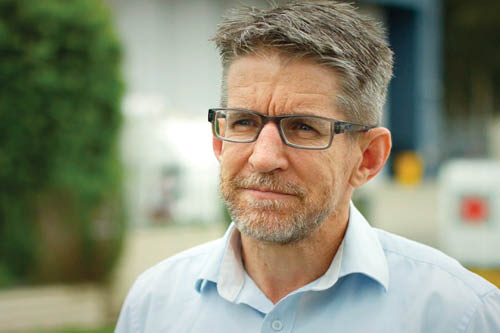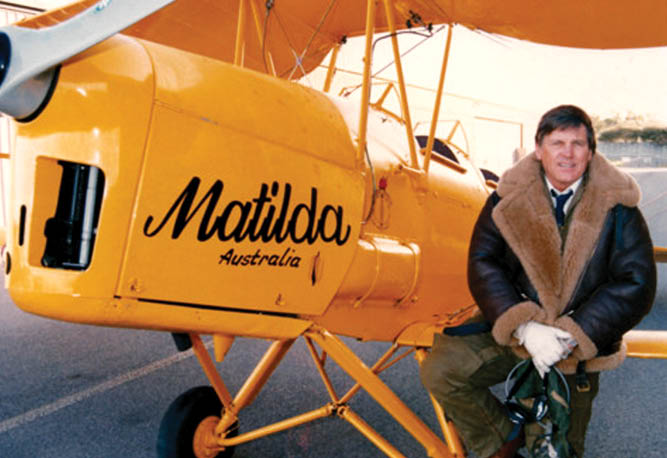
In his 23rd year with BAE Systems Australia, Andrew Chapman is at the forefront of Defence aviation operations in Australia as the company’s Director for Aircraft Sustainment and Training. Despite the impacts of COVID-19, the organisation had a largely successful 2021, achieving many milestones including new contracts for F-35 sustainment and the Hawk Lead-In Fighter while inducting the first F-35 into the South Pacific depot at Williamtown, a precinct that is fast becoming an international aero hub and the centre of fast jet sustainment in Australia.
We sat down with Andrew to find out what is next for 2022 and beyond.
1. Tell us a bit about your background leading into your role as Director of Aircraft Sustainment and Training?
After completing a Bachelor of Electrical and Computer Engineering in 1997 at the Queensland University of Technology, I joined the Royal Australian Air Force as an Avionics Technician. After just over four years, I did a stint with Boeing as a Systems Engineer before transferring to BAE Systems Australia. Twenty-three years later I am pleased to say I am still with the nation’s biggest Defence prime.
Early on at BAE, I worked in various roles within the business on both LIF and F-35 programs, working my way up to the Head of Engineering and General Manager before taking on the role of Director in 2019.
2. What are the challenges and highlights you have experienced as Director?
Ensuring our business meets the customer’s demands during a global pandemic has certainly been a challenge! The daily tasks of working to maintain a sustainable operation in the midst of lockdowns certainly presented difficulties. But many of our team members at Williamtown and RAAF Base Pearce worked through the pandemic and guaranteed delivery to the customer no matter what. That is a massive point of pride for me.
Beyond the pandemic, our team had such an incredible year in 2021. Achievements including the plan withdraw date extension for Lead in Fighter to 2031 and the first F-35 inducted into the South Pacific depot. These successes come from a fundamental belief in what we are doing here in Williamtown. There is a huge sense of pride felt by everyone and the understanding of the massive contribution we make to the defence of this country.
3. Can you tell us about the establishment of F-35 sustainment capability in Australia?
BAE Systems Australia has been assigned as the Regional Product Support Provider (PSP) directly supporting the F-35 Joint Program Office’s (JPO) Global Support Solution (GSS) approach to sustaining a global fleet of 3000+ F-35 aircraft.
Specifically, we have been assigned to support the following regional F-35 sustainment capabilities:
- Regional Heavy Airframe Depot Maintenance Repair Overhaul and Upgrade (MRO&U) for Southern Pacific region;
- Regional F-35 Warehouse for Asia-Pacific region and;
- Regional F-35 Component MRO&U Depot Assignments for Asia-Pacific region.
We also provide maintenance and supply chain support directly to the RAAF with highly skilled members of our team embedded at RAAF Base Williamtown sustaining the F-35.
Since winning our F-35 support role in Australia and the Asia–Pacific region, the company has been growing its capability to support the F-35. We already have in excess of 100 people working across sustainment in Australia and forecast this to grow to 360 Australian jobs across aerospace maintenance operations over the next ten years, with the majority based in NSW. Work is also underway to both modify and extend current facilities and build new facilities at the company’s site in Williamtown NSW to support this growth.
4. How does BAE’s involvement with the international F-35 program lead the way on security for the nation?
BAE is a key part of the industry team globally. We deliver up to 15% of each aircraft, manufacturing crucial components within Australia and provide sustainment support to the international F-35 program. Our participation in the global program along with our many years providing fast jet sustainment to the RAAF on other platforms further strengthens Australia’s Defence industry and our national capability. We are proud to play a major role in the F-35 Enterprise protecting and supporting the RAAF.
5. What benefits does the F-35 sustainment program bring to the Hunter region?
Establishment of F-35 sustainment capability in the heart of the Hunter will continue to attract global talent to the region and position the Hunter for export opportunities into the Asia Pacific. This provides local supply chain opportunities and a range of economic benefits. We expect to develop a specialist supply chain of more than 70 SMEs by 2025.
6. What are the key focus areas for F-35 sustainment in 2022?
In 2022, we have three key focus areas. The first is to continue preparation of the F-35 South Pacific regional airframe depot at our Williamtown site. This involves meeting the RAAF declaration of F-35 Final Operational Capability (72 aircraft) by the end of 2023 and working towards the ramp up of F-35 global depot flow plan in 2023/2024. Second is the activation of the F-35 Asia-Pacific Regional Warehouse at BAE Systems Williamtown from mid-year. And finally, the delivery of the RAAF sovereign F-35 Air Vehicle Support Services at RAAF Base Williamtown. This is comprised of on-base aircraft and workshop maintenance services, warehouse management, ground support equipment maintenance, provision of general usage consumables and Quality/Safety maintenance management for the F-35 fleet.
7. What will the $80m F-35 AVSS contract mean for the future expansion of operations at Williamtown?
The AVSS contract allows us to build on our position on the program to directly support the RAAF with their operational requirements at Williamtown and Tindal. Our many years of experience in fast jet sustainment and our existing position on the program allows us to help the RAAF deliver its aircraft availability requirements. Having sustainment operations both on the BAE Systems site and on base with the RAAF, allows us to grow capability in an integrated manner driving better capability outcomes and efficiencies.
8. What does this investment of aero hub foundations in the Hunter region mean for future jobs in years to come?
Investment in these assigned F-35 capabilities enables a footprint for the Hunter Region to build on to support further Defence and industry opportunities. The growing of these capabilities will enable high-end Defence jobs to support future advanced defence platforms, including the sustainment of advanced technology.
To learn more about the F-35 program, visit www.baesystems.com













